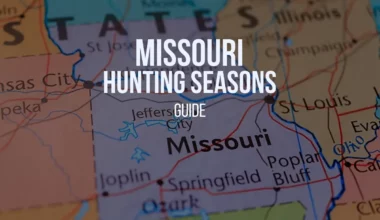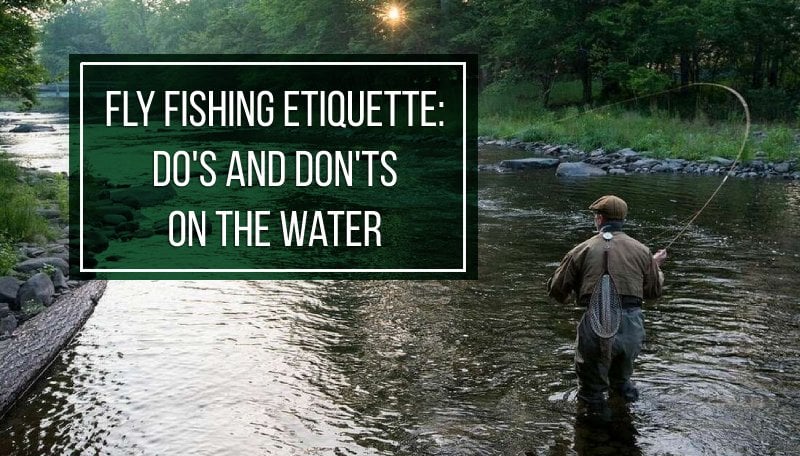Indiana is the 38th largest state in the USA, so some might think it is not endowed with plentiful hunting opportunities. While not as outstanding as in some states, hunting opportunities in Indiana are not scarce by any means. And, as always, those are prominently accompanied by breathtaking vistas of rolling hills, shallow valleys, dense forests and even prairies scattered across the state. Some hunting seasons have already begun, some have already ended, and others are only about to begin. In this guide to Indiana hunting seasons, we cover the major game seasons together with dates (set or preliminary), requirements, regulations and restrictions.
All relevant information in more detail can be found on Indiana Hunting page on eRegulations.
Table of Contents
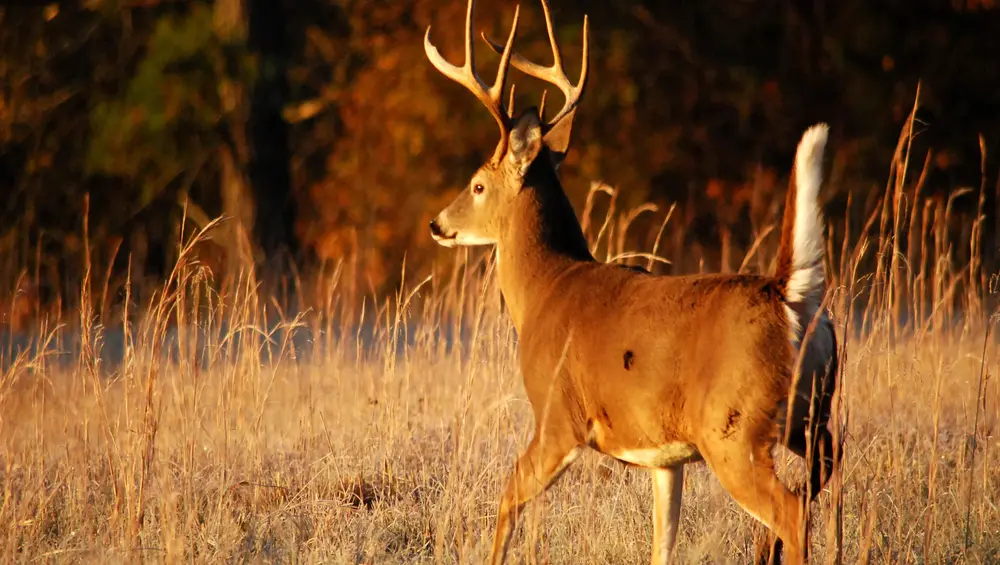
Deer Hunting in Indiana
Deer undoubtedly holds the title of the favorite game species across the country. Every state offers the opportunity to hunt bucks, and Indiana is no exception. Whether it’s with traditional firearms, muzzleloaders, or bows and arrows, the approaches to deer hunting are diverse. And so are the regulations.
Deer Seasons Dates in IN
Indiana offers a variety of deer hunting seasons to cater to different hunting preferences, including archery, firearm, muzzleloader, youth deer, and reduction zone seasons.
Deer Archery Season | October 1, 2024 – January 5, 2025 |
Deer Firearm Season | November 16 – December 1, 2024 |
Deer Muzzleloader Season | December 7-22, 2024 |
Deer Youth Season | September 28-29, 2024 |
Deer Reduction Zone Season | September 15, 2024, to January 31, 2025 |
Deer Hunting in IN: Licenses, Rules, and Regulations
To hunt deer in Indiana, you must obtain the appropriate license depending on the season and preferred method of hunting.
- Separate licenses are required for firearms, archery, crossbow, muzzleloader and deer reduction zone hunting.
- Special licenses such as the bonus antlerless license and deer license bundle are available but have specific restrictions.
- Exemptions to license requirements include Indiana farmland owners, full-time military personnel on leave, and non-resident youth with an Indiana resident guardian, among others.
- Bag limits are enforced, with one deer per license rule, except under certain conditions like acquiring a deer license bundle or youth hunt/trap license.
Indiana Deer Hunting Licenses
There are various licenses available tailored to different seasons and hunting methods.
- Firearms, Archery, and Muzzleloader Licenses: Allow for harvesting specific types of deer during their respective seasons using respective weapons.
- Bonus Antlerless License: Allows for harvesting additional antlerless deer depending on the county quota.
- Deer Reduction Zone License: Necessary for hunting within designated reduction zones.
- Deer License Bundle: Includes all major deer hunting licenses except for the reduction zone season.
Deer Bag Limit
Indiana hunters are allowed to harvest 1 antlered deer per year. This limit applies regardless of how many hunting licenses a person acquires. The number of antlerless deer varies by license:
- Deer Archery License: 2 antlerless deer. Alternatively, 1 antlered and 1 antlerless deer
- Deer Firearm License: 1 antlered deer only.
- Deer Muzzleloader License: 1 antlered deer. Alternatively, 1 antlerless deer
- Deer Resident Youth License: 1 antlered deer AND the number of bonus antlerless deer per county quota
- Deer License Bundle: 1 antlered deer AND 2 antlerless deer
- Deer Reduction Zone License: 1 antlered deer (“Earn-a-buck” Regulation*) AND 9 antlerless deer. Alternatively, 10 antlerless deer.
*Earn-a-buck Regulation stipulates that hunters in deer reduction zones are to harvest an antlerless deer BEFORE harvesting an antlered deer. That limit only applies to the reduction zone bag limit which applies in addition to all other bag limits.
What are Deer Reduction Zones?
Deer reduction zones are designated areas that are reported to have high deer populations and are heavily populated or used by humans. To prevent potential ecological issues, deer-vehicle collisions and personal property damage, the DNR designates these areas as eligible for sport hunting.
The ultimate goal of this designation is to prevent deer-human conflict and increase deer wariness of humans and not to thin out the deer population.
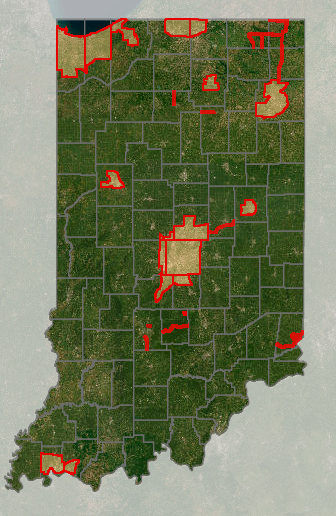
Legal Hunting Hours
Legal hunting hours are from 30 minutes before sunrise to 30 minutes after sunset.
Harvest Report and Tagging
Tagging: Upon harvesting a deer, a hunter is to fill out a temporary tag on paper, detailing their name and address, the deer’s sex, the license number (if applicable) and the date of the kill. A hunter is required to keep the deer carcass within immediate physical possession and sight until it has been tagged with the completed temporary transportation tag. This tag must be secured to the deer before the hunter departs from the location.
Reporting: Hunters are to register their harvested deer within 48 hours of the kill. You can do so through one of the three means:
- Online DNR’s CheckIN Game system
- Check station or a licensed retailer who will enter the same information through the CheckIN Game system
- By calling the Indiana Department of Natural Resources (1-800-419-1326) with a $3 fee.
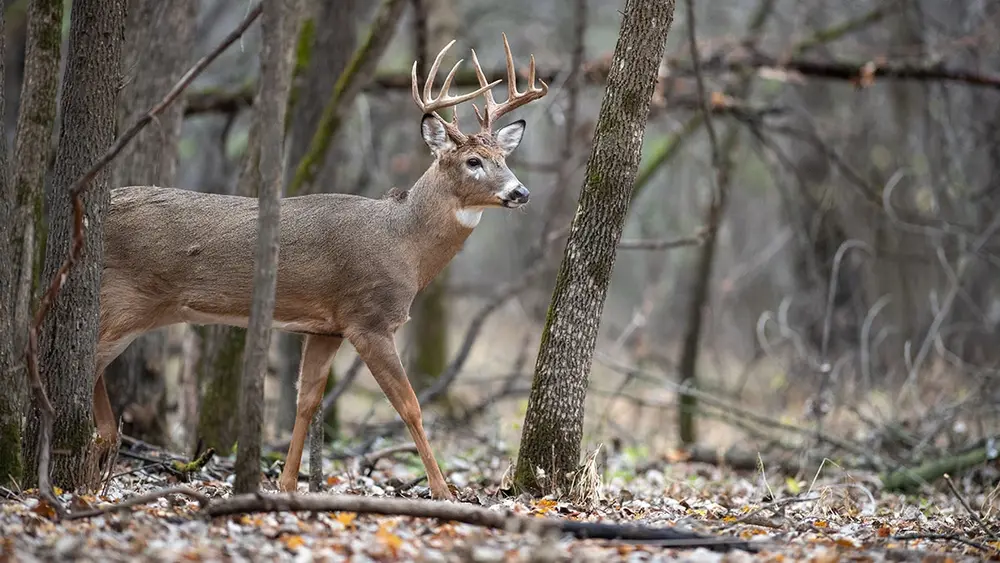
Indiana Deer Hunting Weapons and Ammo
The state of Indiana offers a variety of seasons for deer hunting, each allowing the use of specific types of weapons and ammunition. Understanding these regulations is crucial for every hunter wishing to comply with state laws and ensure a successful hunt.
Firearm Season:
During the firearm season, which begins the first Saturday after Veterans Day and spans 16 days, hunters can use rifles that meet specific cartridge measurements. The cartridges must have a minimum case length of 1.16 inches and a maximum length of 1.8 inches. Additionally, the bullets fired from these cartridges must be .357 inches in diameter or larger. Full metal jacketed bullets are prohibited during this season. Private land allows for the usage of cartridges with a bullet diameter of .243” and higher but hunters may not have more than 10 of these cartridges while hunting deer.
Archery Season:
During this period, hunters are permitted to use conventional archery equipment, including longbows, recurve bows, or compound bows. The minimum draw weight is 35 lbs. Arrows must have metal, metal-edged, napped flint, chert or obsidian broadheads. Crossbows are authorized for use throughout the entire archery season and must have a minimum draw weight of 125 lbs.
Muzzleloader Season:
Muzzle-loaded rifles and shotguns are required to have the minimal barrel caliber of .44” minimum. Bullet diameter is set at .357” minimum. Firearms are to have powder and bullets loaded from the muzzle and should be single-bullet ones. Saboted bullets are permitted and so are multiple-barreled guns.
Indiana Deer Hunting Regulations
- Blaze orange is to be worn by ALL hunters during the firearm, muzzleloader, deer reduction zone and youth deer seasons regardless of which type of weapon they use. An occupied ground blind must also have at least 144 square inches of hunter orange that is visible on each side of the blind during those seasons.
- Infrared sensors, drones or electronic deer calls are prohibited.
- Tree stands are allowed for hunting deer during all deer hunting seasons. However, it is illegal to set or hunt from a permanent tree blind on state-owned or state-leased lands.
- Snares, salt and bait are prohibited.
- The usage of hunting dogs and other domesticated animals to take deer is prohibited.
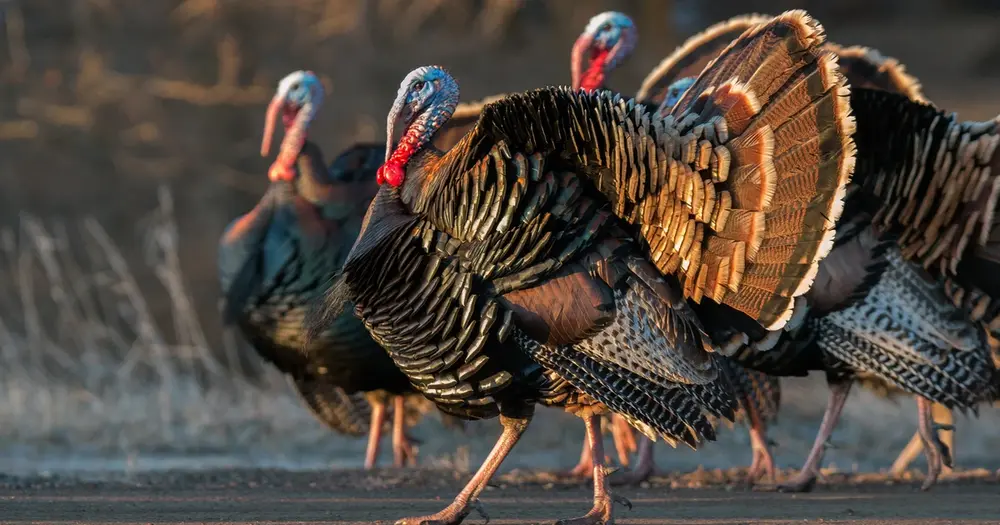
Wild Turkey Hunting in Indiana
Turkey is another hunter’s favorite. Even though getting a fresh turkey to serve on a Thanksgiving dinner won’t be an option, you can preserve one for that very occasion.
Wild Turkey Seasons Dates in IN
Spring Season | April 24 – May 12, 2024 |
Fall Season | October 1-27, 2024 (Firearm season October 16 – 27) December 7, 2024 – January 5, 2025 |
Wild Turkey Hunting License
To hunt wild turkey in Indiana, hunters must obtain a valid turkey hunting license and a Game Bird Habitat Stamp, except for those who hold a lifetime comprehensive hunting, lifetime comprehensive hunting and fishing, or resident youth hunt/trap license since they already include the Game Bird Habitat Stamp privilege. A separate license is required for hunting during the spring and fall seasons.
Wild Turkey Bag Limits
- Spring Season: 1 bearded or male turkey per hunter.
- Fall Season: 1 bird of either sex during the fal
Wild Turkey Hunting Hours
Hunting is permitted from one-half hour before sunrise to sunset across the state. For DNR properties managed by the Division of Fish & Wildlife, spring season hunting hours extend from one-half hour before sunrise until noon for properties on Central Time and until 1 p.m. for properties on Eastern Time.
Wild Turkey Tagging and Reporting
Upon harvesting a turkey, the hunter must immediately complete a temporary transportation tag including details such as their full name and address, sex of the turkey, license number (if applicable), and the date the turkey was taken. Harvested turkeys must be registered within 48 hours of the kill through the DNR’s CheckIN Game system, via phone call, or at a check station, where a confirmation number will be issued to be recorded on the temporary transportation tag.
Wild Turkey Legal Equipment
Legal hunting equipment includes:
- Shotguns of .410 caliber and sizes 10-, 12-, 16-, 20-, or 28-gauge loaded with pellets of size No. 4, 5, 6, 7, 7½, or Tungsten Super Shot 8, 9, and 10.
- Muzzleloading shotguns not smaller than 20-gauge and not larger than 10-gauge loaded with the specified pellet sizes.
- Bow and arrow.
- Crossbow.
Wild Turkey Regulations
Several key regulations include:
- Hunter orange is to be worn while hunting turkeys on Dec. 7-22, when it overlaps with deer muzzleloader season.
- The use of dogs, domesticated animals, live decoys, recorded or electronically powered calls, and bait is illegal.
- During the youth season, the supervising adult may not hunt or possess hunting equipment, except for a handgun carried lawfully.
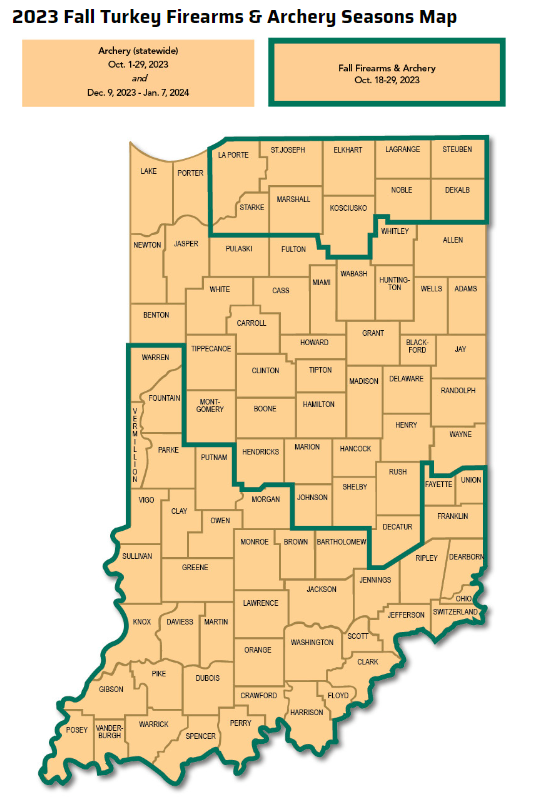
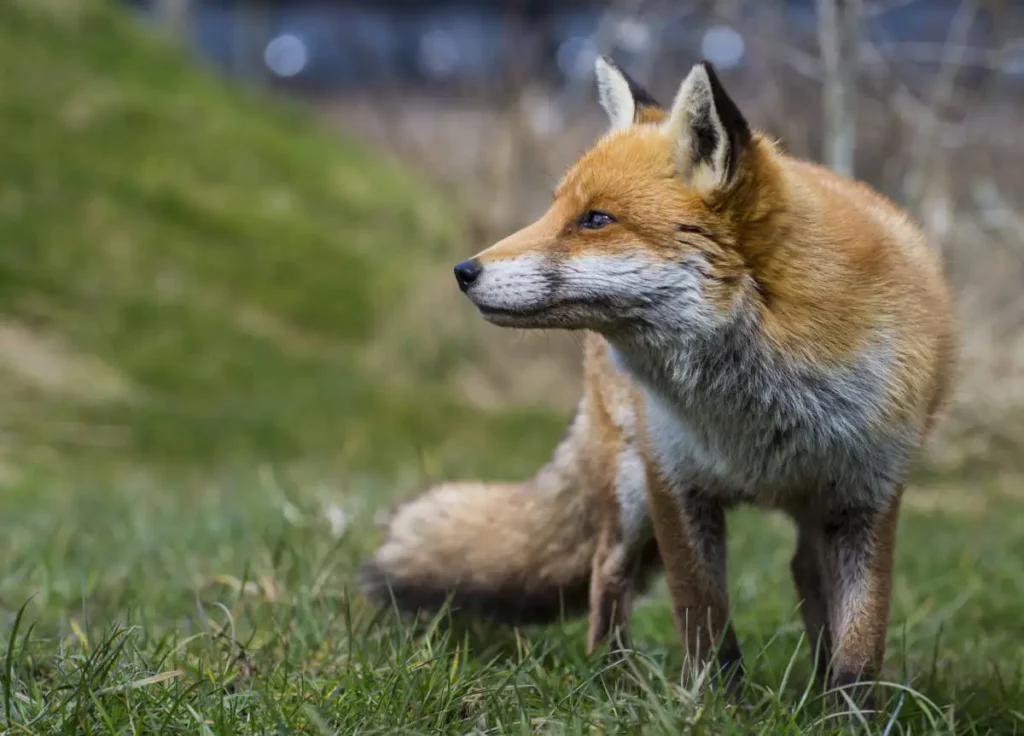
Furbearers Hunting in Indiana
With fur-bearing animals, hunting is only one of the two options. Trapping might prove to be a more effective way of getting your hand on the owners of luxurious furs. Whichever method you choose, make sure to stick to the rules and stay humane.
Furbearer Seasons Dates in IN
Furbearer hunting seasons in Indiana span various periods throughout the year, depending on the species:
Red & Gray Fox | October 15, 2024 – February 28, 2025 |
Coyote & Striped Skunk | October 15, 2024 – March 15, 2025 |
Raccoon & Opossum | November 8, 2024 – January 31, 2025 |
Mink, Muskrat, Long-tailed Weasel | November 15, 2024 – January 31, 2025 |
Beaver | November 15, 2024 – March 15, 2025 |
Dog Running (Chasing season only – no hunting) | February 1 – October 25, 2024 |
Furbearer Hunting License
A valid Indiana hunting license is required to hunt furbearers, including beaver, coyote, gray fox, long-tailed weasel, mink, muskrat, opossum, raccoon, red fox, and striped skunk. License exemptions and additional details are available through the DNR or on the wildlife.IN.gov website.
Furbearer Bag Limits
The only species that has a bag limit is river otter (seasonal bag limit of two). There is also a statewide quota of 750 river otters.
Furbearer Protected Species
Badgers and bobcats are currently protected species in Indiana. It is illegal to take these animals. Accidental captures should be reported to Indiana Conservation Officers, with no penalty for such reports.
Possession of Furbearer Hides & Carcasses
Lawfully obtained untanned hides or unprocessed carcasses of furbearers taken during the season can be possessed with no deadline. The sale of legally harvested furbearers or untanned hides can only be made to licensed fur buyers.
Furbearer Regulations
- Using motorized vehicles and boats for hunting is prohibited
- A hunter needs to carry a continuously burning light visible for at least 500 feet when pursuing furbearers between sunset and sunrise.
- Disturbing the dens or nests of any animal in the pursuit of hunting is prohibited
- Using or carrying tree-climbing or cutting equipment to reach furbearers is prohibited.
Furbearer Trapping Seasons Dates in IN
Trapping seasons generally align with the hunting seasons for each species, providing opportunities for the sustainable harvest of furbearers while regulating their populations:
Red & Gray Fox | October 15, 2024 – January, 31, 2025 |
Coyote & Striped Skunk | October 15, 2024 – March 15, 2025 |
Raccoon & Opossum | November 8, 2024 – January 31, 2025 |
Mink, Muskrat, Long-tailed Weasel | November 15, 2024 – January 31, 2025 |
Beaver | November 15, 2024 – March 15, 2025 |
River Otter (in designated counties) | November 15, 2024 – March 15, 2025 (or until the quota is met) |
Furbearer Trapping Regulations
A valid Indiana trapping license is required to set traps for furbearers. Traps must be checked and animals removed at least once every 24 hours, with some exceptions for certain types of deadly traps. Trapped furbearers (except for raccoons, foxes, and coyotes which may be kept alive) must be either released back into the wild in the same county where they were captured within 24 hours or be humanely euthanized right after they are removed from the trap or as soon as they are transported away from the location of the trap.
Trapper education courses are offered to cover basic trapping methods, handling of the catch, and the responsibilities of trappers.
Possession of Live Furbearers
The possession of live furbearers is permitted for raccoons, red foxes, gray foxes, and coyotes during the trapping season. Specific enclosure standards and care requirements must be met to ensure the well-being of the animals.
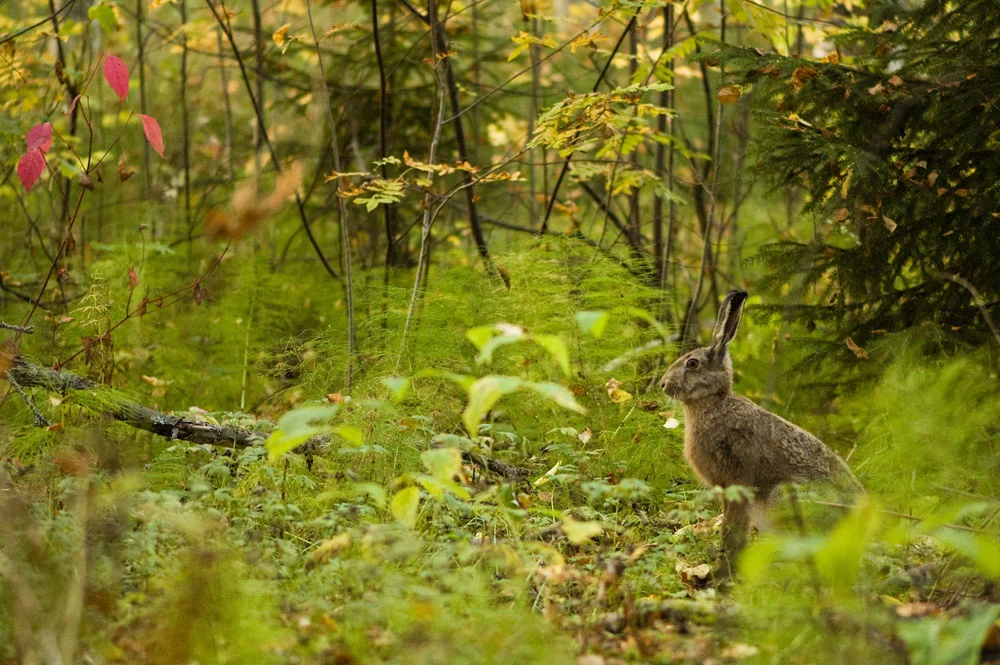
Small Game Hunting in Indiana
If it is the thrill of hunting you are after and not pompous game trophies, there are plenty of opportunities for small game hunting. The bag limits are also much more forgiving, so you can win in quantity if not prestige of the trophies.
Small Game Seasons Dates in IN
Rabbit (Except for Swamp Rabbit) | November 1, 2024 – February 28, 2025 |
Squirrel | August 15, 2024 – January 31, 2025 |
Amphibian (Green Frog & Bullfrog) | June 15, 2024 – April 30, 2025 |
Amphibian (Eastern Snapping, Smooth Softshell, Spiny Softshell Turtles) | July 1, 2024 – March 31, 2025 |
License Requirements
To hunt small game in Indiana, hunters must possess a valid hunting license. Specifics include:
- Small Game (Rabbit, Squirrel): A valid hunting license is required.
- Amphibians (Frog, Turtle): Hunters can use either a valid hunting or fishing license.
Hunter orange clothing requirements are in place for both rabbit and squirrel hunting during certain periods, ensuring hunter safety in the field.
Small Game Bag Limits
There are no specific bag limits for rabbits and squirrels. For amphibians, the collection limits are more defined:
- Game Turtles (Eastern Snapping, Smooth Softshell, Spiny Softshell Turtles): The daily bag limit is 4, with a possession limit of 8. These turtles must be at least 12 inches in carapace length to be legally taken.
- Game Frogs (Green Frog & Bullfrog): The daily bag limit is 25, with a possession limit of 50.
Small Game Regulation in Indiana
- Swamp rabbits are protected species that are illegal to hunt, take or possess.
- Flying squirrels are protected species that are illegal to hunt or possess without a special permit.
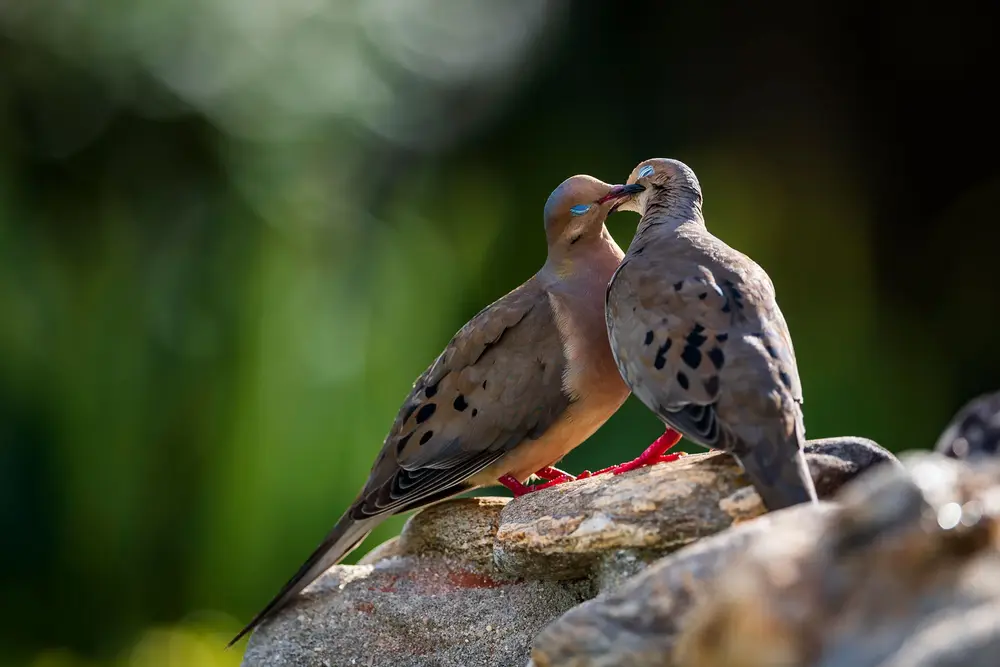
Migratory Bird & Waterfowl Hunting in Indiana
If you prefer feather to fur, Indiana also offers plenty of hunting opportunities to grab. You can spend the whole fall hunting – so numerous are the bird species you can hunt.
Migratory Bird & Waterfowl Seasons Dates in IN
Dates of Bird Hunting Seasons haven’t yet been specified for 2024. However, the general rule is that the dates might change within two or three days compared to the previous year. Here are the dates of Waterfowl & Migratory Bird Seasons in Indiana for 2023.
Mourning Doves | September 1 – October 15, November 1-26 December 16 – January 3 |
Sora | September 1 – November 9 |
American Woodcock | October 15 – November 28 |
Snipe | September 1 – December 16 |
Teal | September 9-24 |
Ducks, Coots, & Mergansers | North Zone: October 28 – December 17, December 26 – Jan. 3 Central Zone: November 4-12, November 24 – January 13 South Zone: November 11-12, December 2 – January 28 |
Geese: | North Zone: September 9-17, October 28 – November 5, November 18 – February 11 Central Zone: September 9-17, November 4-18, November 24 – February 11 South Zone: September 9-17, November 11 – February 11 |
License Requirements
- Youth (15 and younger): Need a valid hunting license and HIP number.
- Youth (16-17): Require a valid youth hunting license, HIP number, and Federal Duck Stamp.
- Adults (18+): Must have a valid hunting license, HIP number, Federal Duck Stamp, and State Waterfowl Stamp.
Lifetime license holders and those exempt from Indiana license requirements still need a Federal Duck Stamp and HIP number to hunt waterfowl.
What is HIP?
HIP stands for the Harvest Information Program, a collaborative initiative between the U.S. Fish and Wildlife Service and state wildlife agencies, designed to gather hunter-reported data on the harvest of migratory game birds. The purpose of HIP is to compile accurate harvest estimates for migratory birds across the nation. This information plays a critical role in the conservation of these species by helping wildlife management agencies make informed decisions regarding hunting seasons, bag limits, and overall population management strategies based on sound scientific evidence.
In Indiana, as in other states, all hunters targeting coots, doves, ducks, mergansers, geese, snipe, sora, teal, and woodcock are required to register with HIP before commencing their hunting activities. Registration provides each hunter with a unique HIP number, which must be recorded on their hunting license. This HIP number serves as proof of participation in the program and must be validated from the date of registration through the close of the last current migratory bird hunting season.
Migratory Birds & Waterfowl Bag & Possession Limits
The possession limit on waterfowl and migratory birds is 3 times the daily bag limit (except for light geese, which have no possession limit).
Mourning Doves: 15
Sora: 25
American Woodcock: 3
Snipe: 8
Teal: 6
Ducks: 6 (no more than 4 mallards (2 of which may be hens), 3 wood ducks, 2 canvasbacks, 1 pintail, 2 redheads, 2 black ducks, 1 mottled duck, and 1 or 2 scaup)
Coots: 15
Mergansers: 5 (no more than 2 hooded mergansers)
Geese:5 (dark geese), 20 (light geese)
Migratory Birds & Waterfowl Regulations
- Hunters can use motorboats for hunting provided they adhere to specific conditions such as the boat being at rest or anchored.
- Migratory game birds in possession must retain one fully feathered wing or head for identification until reaching the hunter’s residence or processing facility.
- All harvested birds must be retrieved and retained in the custody of the hunter in the field.
- Proper tagging is required for any migratory game birds transferred to another person or left at a location.
Migratory Birds & Waterfowl Restrictions
- Use of traps, snares, nets, rifles, explosives, or other prohibited methods is illegal.
- Shotguns cannot hold more than three shells unless plugged.
- Hunting from moving vehicles or boats under power is prohibited.
- Live decoys, recorded or electronically amplified calls, or hunting over baited areas are prohibited.
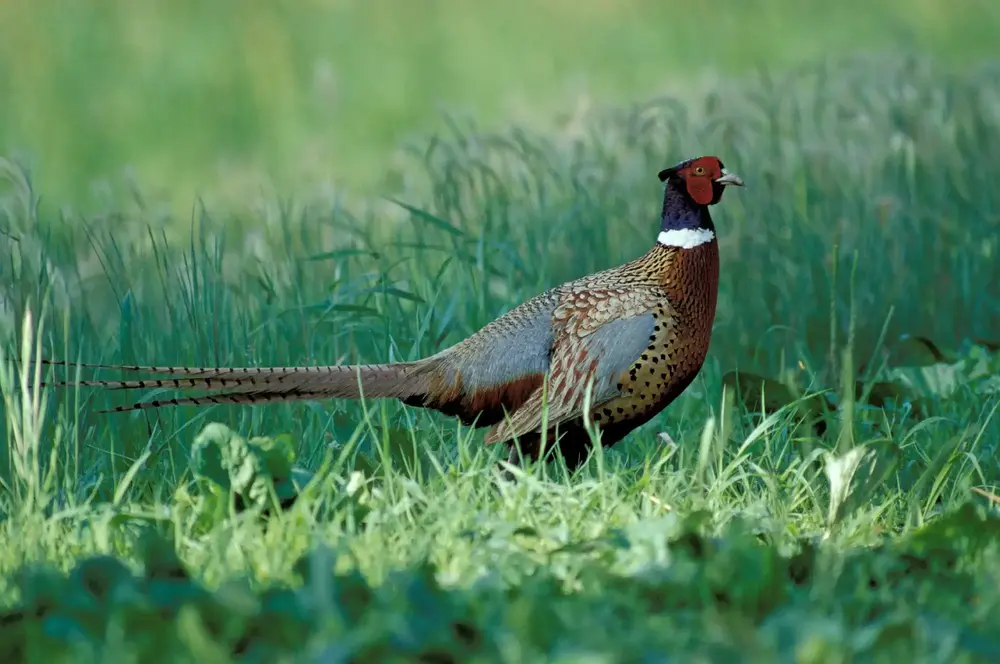
Game Bird Hunting in Indiana
If you save your stones for a bigger bird or don’t want to get your feet wet, well, there are also several bird game species for you to target.
Game Bird Hunting Seasons Date
As with waterfowl & migratory birds, the dates for hunting game birds haven’t yet been specified. It is reasonable to expect them to be close to the dates of the previous year, which were as follows:
Pheasant | November 1 – December 15. Put-and-Take – Since November 18. |
Quail | North Zone – November 1 to December 15. South Zone – November 1 to January 10. |
Crow | July 1 – August 15 and December 13 – March 1 |
Other Wild Birds | English sparrows, European starlings, monk parakeets, and feral pigeons can be taken at any time. |
Game Bird License Requirements
To hunt game birds in Indiana, hunters must possess:
- A valid hunting license.
- An Indiana Game Bird Habitat Stamp (for hunting pheasants and quail).
Hunter orange clothing requirements must be met while hunting pheasants and quail to ensure safety in the field.
Game Bird Daily Bag Limits
- Pheasant: 2 male pheasants. During Put-and-Take hunts – 2 birds of either sex, except at Pigeon River, Willow Slough, and Winamac FWAs, where only roosters may be taken.
- Quail: The North Zone – 4 birds.
The South Zone – 8 birds.
There are no bag limits for crows
Game Bird Regulations
- Female pheasants (hens) are protected outside of designated put-and-take hunts.
- When transporting pheasants, the head and head plumage must remain attached for identification purposes.
- A recommended shotgun gauge/shot size for pheasant hunting is 12- or 20-gauge loaded with 4- to 6-size shot, and for quail hunting, 12- or 20-gauge loaded with 6- to 9-size shot.
- Non-toxic shots are required when hunting pheasant on some DNR properties.
- Hunters can reserve put-and-take pheasant hunts online, selecting the date, property, and area for their hunt.
- On days when pheasants are released and hunted in designated put-and-take areas, hunters are restricted from taking game animals other than pheasants.
Game Bird Restrictions
- Shooting female pheasants is illegal except during put-and-take hunts in designated areas.
- There are no equipment or ammunition restrictions mentioned for quail hunting, but local ordinances and property-specific regulations may apply.
- For crows, there are no restrictions on the use of calls or decoys, and they may be taken with bow and arrow, crossbow, or firearm, following local ordinances.
- Control of certain wild bird species is allowed under specific conditions related to crop damage or public health concerns.
FAQs
In Indiana, hunters can look forward to hunting deer, wild turkey, furbearers (such as raccoons and foxes), waterfowl (like ducks and geese), migratory birds, game birds (including pheasants and quail) and various species of small game animals.
Indiana’s deer hunting seasons encompass archery, firearm, muzzleloader, youth deer, and reduction zone seasons, each with specific dates set within the 2024-2025 period.
Hunters in Indiana are permitted to harvest one antlered deer annually. The allowable number of antlerless deer is determined by the specific license obtained.
Deer reduction zones target areas with dense deer populations to mitigate deer-human conflicts and foster deer wariness of humans through regulated sport hunting.
Turkey hunting seasons in Indiana are divided into spring and fall sessions. Spring season lasts from April 24 and extends through May 12, 2024. Fall season is from October 1 to October 27, 2024, and from December 7, 2024, to January 5, 2025.
During the spring season, hunters may take one bearded or male turkey each. In the fall, the regulation allows for the harvesting of one bird of either sex per hunter.
Yes, Furbearer seasons vary by species, with dates ranging from October 15, 2024, through March 15, 2025, depending on the animal.
Yes, there’s a Dog Running (Chasing) season where no hunting is allowed, only chasing, for training and exercising dogs lasts from February 1 till October 25.


